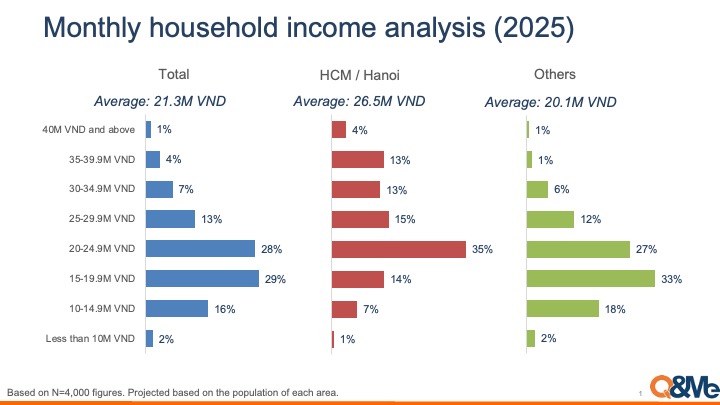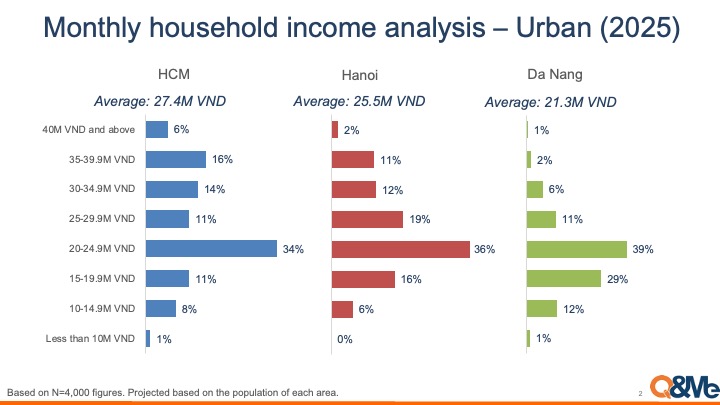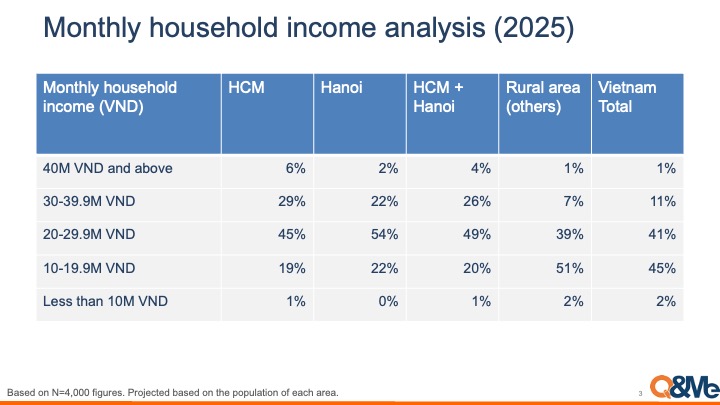-------------- Lifestyle --------------
Understanding household income in Vietnam remains a challenge due to limited available data. Unlike some countries where detailed statistics on income distribution are regularly published, Vietnam lacks an official and comprehensive database covering nationwide household earnings. This gap makes it difficult for businesses and policymakers to assess income trends and market opportunities effectively.
To bridge this knowledge gap, we conducted nationwide interviews to collect real-life data on Vietnamese household income. Our research covers both urban and rural areas, allowing us to analyze differences between key metropolitan regions such as Ho Chi Minh City and Hanoi, as well as other cities and provinces. By gathering direct responses from households, we aim to provide a clearer picture of income distribution and its implications for businesses operating in Vietnam.
One of the most striking findings from our data is the clear gap between urban and rural income levels. Urban areas, particularly Ho Chi Minh City and Hanoi, have a higher proportion of middle- and upper-income households, while rural areas have a larger percentage of lower-income households.
For example, only 0.7 percent of households in Ho Chi Minh City and Hanoi earn less than 10 million VND per month, compared to 2.2 percent in rural areas. Meanwhile, households earning 40 million VND or more account for 3.9 percent in Ho Chi Minh City and Hanoi, while rural areas see just 0.6 percent in this bracket. These numbers highlight the stark income disparity, influenced by economic development, job opportunities, and industrial concentration.
Looking at the mid-range income brackets, urban areas still show a stronger concentration of households earning 20 to 30 million VND per month, whereas a significant proportion of rural households earn less than 20 million VND. This trend underlines the economic advantage of major cities where salaries tend to be higher, driven by business activities, services, and foreign investments.

Diving deeper into urban regions, Ho Chi Minh City stands out as the wealthiest, followed by Hanoi and Da Nang. Our data reveals that 15.5 percent of households in Ho Chi Minh City earn between 35 and 39.9 million VND per month, compared to 11.0 percent in Hanoi and only 1.8 percent in Da Nang. Additionally, 5.8 percent of Ho Chi Minh City households earn 40 million VND or more, whereas this figure is significantly lower in Hanoi at 1.8 percent and in Da Nang at 0.5 percent.
Da Nang, while a growing economic hub, has a different income distribution compared to the two major cities. It has the highest percentage of households in the 15 to 19.9 million VND range at 28.8 percent, suggesting that while economic growth is evident, higher-income segments remain smaller.

Vietnam’s household income distribution varies significantly across regions. The income levels in Ho Chi Minh City, Hanoi, and Da Nang contrast sharply with rural areas, shaping consumer behaviors, spending patterns, and market potential.
For businesses and marketers, understanding who their target audience is and where they are located is crucial. A product that appeals to consumers in Ho Chi Minh City may not have the same appeal in rural provinces where purchasing power is lower. Audience segmentation, especially income-based segmentation, plays a fundamental role in developing marketing strategies, pricing models, and service offerings tailored to different consumer groups.
By leveraging data-driven insights, businesses can better navigate Vietnam’s evolving economic landscape and optimize their market positioning in 2025 and beyond.
